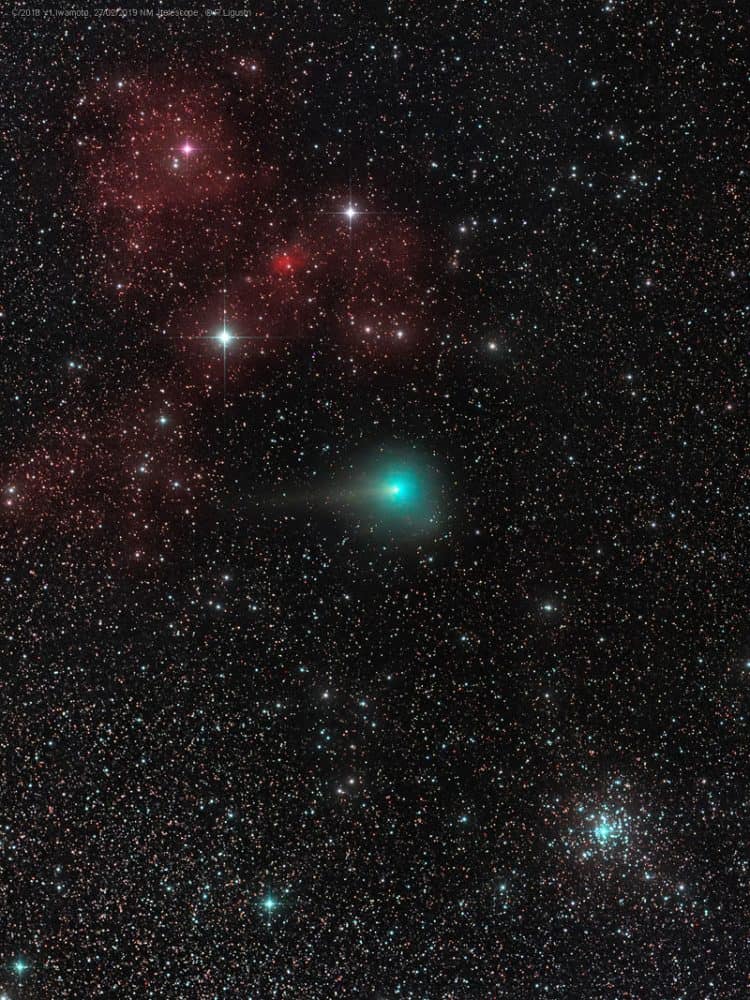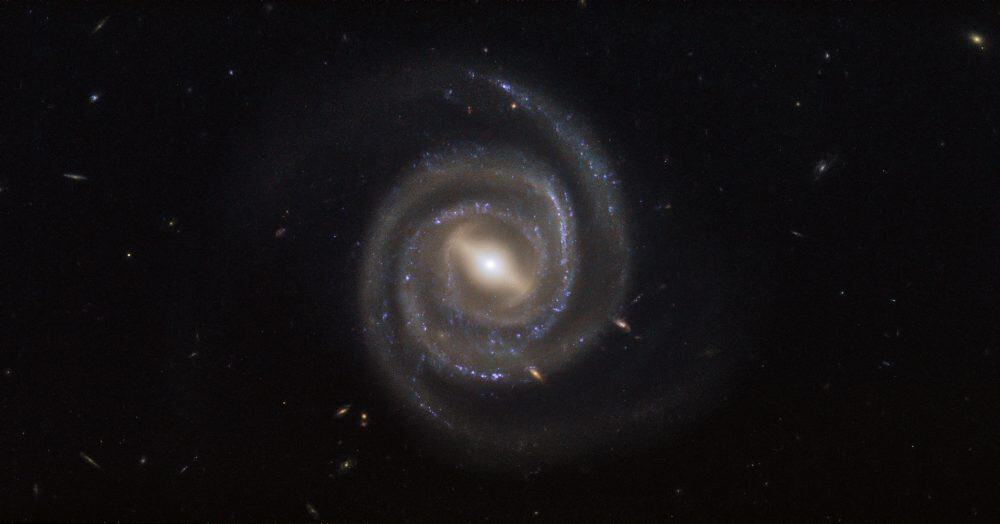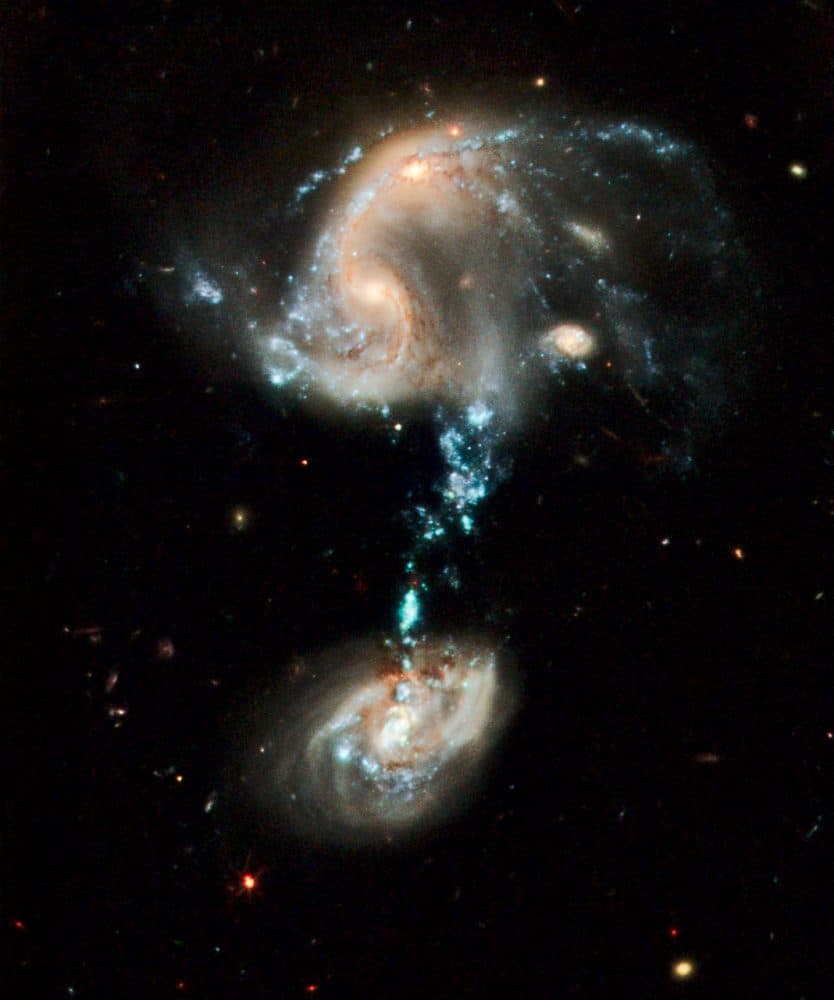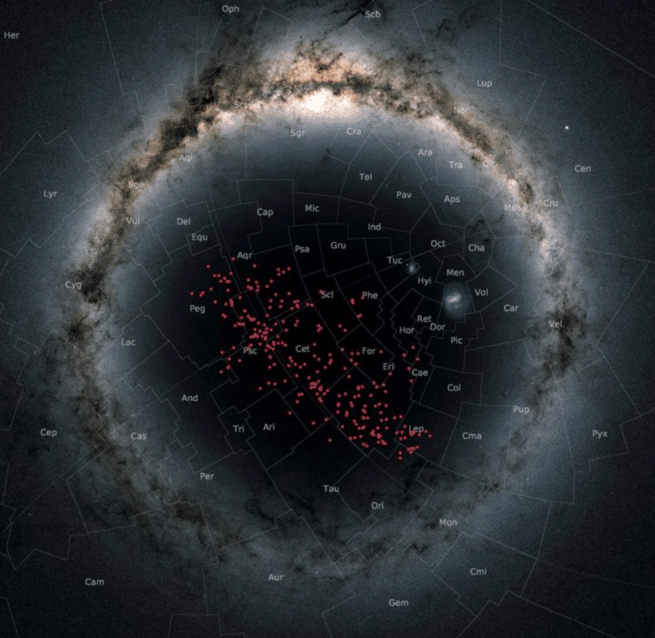Blog
Still racing across planet Earth’s night skies, Comet Iwamoto (C/2018 Y1) shares this pretty telescopic field of view with stars and nebulae of northern constellation Auriga, the Charioteer. Captured onFebruary 27, Iwamoto’s greenish coma and faint tail appear between a complex of reddish emission nebulae and open star cluster M36 (bottom right). The reddish emission is light from hydrogen gas ionized by ultraviolet radiation from hot stars near the region’s giant molecular cloud some 6,000 light-years distant. The greenish glow from the comet, less than 5 light-minutes away, is predominantly emission from diatomic carbon molecules fluorescing in sunlight. M36, one of Auriga’s more familiar star clusters, is also a background object far beyond the Solar System, about 4,000 light-years away. Comet Iwamoto passed closest to Earth on February 12 and is outward bound in a highly elliptical orbit that will carry it beyond the Kuiper belt. With an estimated orbital period of 1,317 years it should return to the inner Solar System in 3390 AD.
more...Ralph Towner (born March 1, 1940, Chehalis, Washington) is an American multi-instrumentalist, composer, arranger and bandleader. He plays the twelve-string guitar, classical guitar, piano, synthesizer, percussion and trumpet.
Born in 1940 in Chehalis, Washington, Towner has made notable recordings of jazz, third stream under strong influence of folk and world music. He began his career as a conservatory-trained classical pianist, who picked up guitar in his senior year in college, then joined world music pioneer Paul Winter‘s “Consort” ensemble in the late 1960s. Along with bandmates Paul McCandless, Glen Moore, and Collin Walcott, Towner left the Winter Consort in 1970 to form the group Oregon, which over the course of the 1970s issued a number of highly influential records mixing folk music, Indian classical forms, and avant-garde jazz-influenced free improvisation. At the same time, Towner began a longstanding relationship with the influential ECMrecord label, which has released virtually all of his non-Oregon recordings since his 1972 debut as a leader Trios / Solos. Towner has also made numerous appearances as a sideman, perhaps most famously on jazz fusion heavyweights Weather Report‘s 1972 album I Sing the Body Electric.
Towner eschews amplification, using only 6-string nylon-string and 12-string steel-string guitars. As a result, he tends to avoid high-volume musical environments, preferring small groups of mostly acoustic instruments that emphasize dynamics and group interplay. Towner also obtains a percussive effect (e.g., “Donkey Jamboree” from Slide Show with Gary Burton) from the guitar by weaving a matchbook among the strings at the neck of the instrument. Both with Oregon and as a solo artist, Towner has made significant use of overdubbing, allowing him to play piano (or synthesizer) and guitar on the same track; his most notable use of the technique came on his 1974 album Diary, in which he plays guitar-piano duets with himself on most of the album’s 8 tracks. In the 1980s, Towner began using the Sequential Circuits Prophet-5 synthesizer fairly extensively, but has since deemphasized his synthesizer and piano playing in favor of guitar.
more...Benny Powell (March 1, 1930 – June 26, 2010) was an African-American jazz trombonist. He played both standard (tenor) trombone and bass trombone.
After leaving Basie, he freelanced in New York City. From 1966 to 1970 he was a member of the Thad Jones–Mel Lewis Jazz Orchestra, playing on Monday nights at the Village Vanguard. Among other engagements, he played in the house band of the Merv Griffin Show, and when the show moved to Los Angeles, California, in 1970 Powell also relocated there. He did extensive work as a session musician, including with Abdullah Ibrahim, John Carter, and Randy Weston. Later in his career Powell worked as an educator, including as part of the Jazzmobile project. Having moved back to New York in the 1980s, he began teaching at the New School for Jazz and Contemporary Music in 1994.
He died in a Manhattan hospital at the age of 80, following back surgery.
more...World Music on Flamenco Fridays featuring Soleá por Bulerías
A hybrid form of the two palos it names. It has the same compás and lyric form as the Soleá, but faster and with a stronger rhythm, reminiscent of the Bulerías. The compás is 12/8, with standard accents as shown

Also sometimes called Bulerías por soleá, Bulería al golpe or Bulería para escuchar, these names, although less common, may be more accurate as it could be argued that the song style is more influenced by the Bulería than the Soleá. A great palo for dancers, it portrays the depth of Flamenco without the sombre stateliness of the Soleá, while also providing a strong rhythmic base to introduce personality into the piece. As with the >Soleá, the structure is traditional:
– Guitar intro
– Song intro
– Footwork intro
– One or two letras (song verses). One of these may be followed by a guitar falsetta. Each will be followed by a footwork transition
– Subida (speed up)
– Escobilla footwork section, accompanied by traditional guitar arpeggio pattern
– Subida
– Bulerías to close
UGC 6093 is something known as a barred spiral galaxy — it has beautiful arms that swirl outwards from a bar slicing through the galaxy’s centre. It is classified as an active galaxy, which means that it hosts an active galactic nucleus, or AGN: a compact region at a galaxy’s centre within which material is dragged towards a supermassive black hole. As this black hole devours the surrounding matter it emits intense radiation, causing it to shine brightly.
But UGC 6093 is more exotic still. The galaxy essentially acts as a giant astronomical laser that spews out light at microwave, not visible, wavelengths — this type of object is dubbed a megamaser (maser being the term for a microwave laser). Megamasers such as UGC 6093 can be some 100 million times brighter than masers found in galaxies like the Milky Way.
more...Lewis Brian Hopkin Jones (28 February 1942 – 3 July 1969) was an English musician, best known as the founder and the original leader of the Rolling Stones. Initially a slide guitarist, Jones would go on to play a wide variety of instruments on Rolling Stones recordings and in concerts, such as rhythm and lead guitar, slide guitar, upright bass, sitar, dulcimer, various keyboard instruments such as piano and mellotron, marimba, harmonica, wind instruments such as recorder, saxophone, drums and numerous others.
Jones and fellow guitarist Keith Richards developed a unique style of guitar play that Richards refers to as the “ancient art of weaving” where both players would play rhythm and lead parts together; Richards would carry the style on with later Stones guitarists and the sound would become a Rolling Stones trademark.
After he founded the Rolling Stones as a British blues outfit in 1962, and gave the band its name, Jones’ fellow band members Mick Jagger and Keith Richards began to take over the band’s musical direction, especially after they became a successful songwriting team. Jones also did not get along with the band’s manager, Andrew Loog Oldham, who pushed the band into a musical direction at odds with Jones’ blues background. At the same time, Jones developed alcohol and drugs problems, and his performance in the studio became increasingly unreliable, leading to a diminished role within the band he had founded. In June 1969, the Rolling Stones asked Jones to leave; guitarist Mick Taylor took his place in the group. Jones died less than a month later, drowning in the swimming pool at his home while under the influence of alcohol and drugs.
Long-time Rolling Stones bass guitarist Bill Wyman said of Jones, “He formed the band. He chose the members. He named the band. He chose the music we played. He got us gigs. … he was very influential, very important, and then slowly lost it – highly intelligent – and just kind of wasted it and blew it all away.
more...John Aloysius Fahey (/ˈfæhi/; February 28, 1939 – February 22, 2001) was an American fingerstyle guitarist and composer who played the steel-string acoustic guitar as a solo instrument. His style has been greatly influential and has been described as the foundation of American Primitive Guitar, a term borrowed from painting and referring mainly to the self-taught nature of the music and its minimalist style. Fahey borrowed from the folk and blues traditions in American roots music, having compiled many forgotten early recordings in these genres. He would later incorporate 20th-century classical, Portuguese, Brazilian, and Indian influences into his work.
He spent many of his later years in poverty and poor health, but enjoyed a minor career resurgence with a turn towards the avant-garde. He also created a series of abstract paintings in his final years. Fahey died in 2001 from complications from heart surgery. In 2003, he was ranked 35th on Rolling Stone magazine’s “100 Greatest Guitarists of All Time” list.
Fahey was born into a musical household in Washington, D.C. in 1939. Both his father, Aloysius John Fahey, and his mother, Jane (née Cooper), played the piano. In 1945, the family moved to the Washington suburb of Takoma Park, Maryland, where his father lived until his death in 1994. On weekends, the family attended performances of the top country and bluegrassacts of the day, but it was hearing Bill Monroe‘s version of Jimmie Rodgers‘ “Blue Yodel No. 7” on the radio that ignited the young Fahey’s passion for music.
In 1952, after being impressed by guitarist Frank Hovington, whom he met while on a fishing trip, he purchased his first guitar for $17 from a Sears, Roebuck catalogue. Along with his budding interest in the guitar, Fahey was attracted to record-collecting. While his tastes ran mainly in the bluegrass and country vein, Fahey discovered his love of early blues upon hearing Blind Willie Johnson‘s “Praise God I’m Satisfied” on a record-collecting trip to Baltimore with his friend and mentor, the musicologist Richard K. Spottswood. Much later, Fahey compared the experience to a religious conversion; he remained a devout disciple of the blues for the rest of his life.
more...Willie Bobo was the stage name of William Correa (February 28, 1934 – September 15, 1983), a Latin and jazz percussionist of Puerto Rican ancestry.
William Correa grew up in Spanish Harlem, New York City. He made his name in Latin Jazz, specifically Afro-Cuban jazz, in the 1960s and 1970s, with the timbales becoming his favoured instrument. He met Mongo Santamaría shortly after his arrival in New York and studied with him while acting as his translator, and later at the age of 19 joined Tito Puente for four years.
The nickname Bobo is said to have been bestowed by the jazz pianist Mary Lou Williams in the early 1950s.
His first major exposure was when he joined George Shearing‘s band on the album The Shearing Spell. After leaving Shearing, Cal Tjader asked Bobo and Santamaría to become part of the Cal Tjader Modern Mambo Quintet, who released several albums as the mambo craze reached fever pitch in the late ’50s. Reuniting with his mentor Santamaría in 1960, the pair released the album Sabroso! for the Fantasy label. Bobo later formed his own group, releasing Do That Thing/Guajira with Tico and Bobo’s Beat and Let’s Go Bobo for Roulette, without achieving huge penetration.
more...Arp 194 comprises a group of galaxies of which at least two are in the process of merging. The merging galaxies, seen in the upper portion of the image, display two bright galactic cores that shine with the yellow light of aging stars. These galaxies have been greatly distorted by their mutual gravitational interaction as can be seen in the dusty, chaotic, spiral features. The smaller bright galaxy to the right of the merging pair is in the background and is not involved in the merger. Perhaps the most striking feature of the merger is the fountain of brilliant, newly formed, star clusters extending from the southern, or lower, portion of the merging galaxies. This string of star cluster seems to be connected to the large galaxy in the lower part of the image. This galaxy, however, is located behind the two merging galaxies. It is unclear if this galaxy actually contributed to the interaction of the merger.
The Arp 194 merger is taking place approximately 600 million light years distant and is located in the constellation of Ursa Major.
This image was assembled with data obtained from the Hubble Legacy Archive. Three filtered images were used for the red, green and blue channels. These were imaged using filters of f815w for red, f555w for green and f450w for blue. A luminance channel was created by combining the three filtered images. The color image was created as a standard LRGB image.
more...
Dexter Gordon (February 27, 1923 – April 25, 1990 LA,CA) was an American jazz tenor saxophonist. He was one of the first players of the instrument in the bebop idiom of musicians such as Charlie Parker, Dizzy Gillespie, and Bud Powell. Gordon’s height was 6 feet 6 inches (198 cm), so he was also known as “Long Tall Dexter” and “Sophisticated Giant”. His studio and performance career spanned over 40 years.
Gordon’s sound was commonly characterized as being “large” and spacious and he had a tendency to play behind the beat. He was known for humorously inserting musical quotes into his solos, with sources as diverse as popular tunes, “Happy Birthday”, and the operas of Wagner. This is not unusual in common-practice jazz improvisation, but Gordon did it frequently enough to make it a hallmark of his style. One of his major influences was Lester Young. Gordon, in turn, was an early influence on John Coltrane and Sonny Rollins. Rollins and Coltrane then influenced Gordon’s playing as he explored hard bop and modal playing during the 1960s.
Gordon was known for his genial and humorous stage presence. He was an advocate of playing to communicate with the audience. A photograph by Herman Leonard of Gordon taking a smoke break at the Royal Roost in 1948 is one of the iconic images in jazz photography. Cigarettes were a recurring theme on covers of Gordon’s albums. One of his idiosyncratic rituals was to recite lyrics from each ballad before playing it.
Gordon was nominated for an Academy Award for Best Actor in a Leading Role for his performance in the Bertrand Tavernier film Round Midnight (Warner Bros, 1986), and he won a Grammy for Best Jazz Instrumental Performance, Soloist, for the soundtrack album The Other Side of Round Midnight (Blue Note Records, 1986). He also had a cameo role in the 1990 movie Awakenings.
more...Chuck Wayne (February 27, 1923 – July 29, 1997 NY, NY) was a jazz guitarist. He came to prominence in the 1940s, and was among the earliest jazz guitarists to play in the bebop style. Wayne was a member of Woody Herman‘s First Herd, the first guitarist in the George Shearing quintet, and Tony Bennett‘s music director and accompanist. He developed a systematic method for playing jazz guitar.
Wayne was known for a bebop style influenced by saxophone players of his time, especially Charlie Parker and Coleman Hawkins. In an era when many guitarists used four-square, mandolin-style picking, with rigid up-down stroke articulation, Wayne developed a technique not widely adopted by others until decades later. He also developed a comprehensive approach to guitar chords and arpeggios – based on generic tetrad forms spanning all possible inversions, in varying degrees of open voicing. This highly analytic approach to the fretboard was later documented in a series of theory books, some released posthumously.
more...A new study published this month in the journal Astronomy and Astrophysics details new observations of a 1,300-light-year-long cluster of more than 4,000 stars that have been moving together through the southern sky for about a billion years now. Distributed like a river of bright lights, a cluster like this has never been found so close to Earth, and could create some useful opportunities for learning about the structure and evolution of the galaxy.
“Similar stream-like structures have been known for quite a while now,” says Stefan Meingast, a researcher from the University of Vienna and the lead author of the new study. They are typically considered remnants of more globular clusters or dwarf galaxies that have been pulled apart and distorted over time, but still share a pattern of movement that hint at a shared origin.
Previous streams have been found in the outskirts of the Milky Way. “Our stream, however, is the first one that was found inside the galaxy, in the immediate vicinity of the sun,” says Meingast. “It therefore is a unique probe for studying the evolution of clusters and for measuring the gravity field of the galaxy.”
There had been previous hints that such a stream existed, through some scattered observations. But this latest investigation is the first to confirm that this is a big, coherent structure. What changed? The European Space Agency’s Gaia mission. An audacious project launched in 2013, Gaia plans to catalog over 1 billion astronomical objects and provide the most precise 3D map of the galaxy ever made.
Yes, it’s a bit strange to think a cluster of stars this large was simply hiding in plain sight for so long, but astronomers know better than to feel embarrassed. When you think about how extraordinarily large space is, trying to locate even several thousand stars streaming through the galaxy is “truly like searching for the needle in the haystack,” says Meingast.
The team was initially tasked with simply using the Gaia data to locate groups of stars that were moving together, and eventually they came across the “structure” of these stars that were moving as a group. The team pinpointed only about 200 stars; the 4,000 figure, and their 1-billion-year age, are extrapolations based on an analysis of stellar brightness, distance, and other factors.
more...Najwa Karam (Arabic: نجوى كرم Lebanese pronunciation: [ˈnaʒwa ˈkaɾam]; born 26 February 1966) is a Lebanese singer and songwriter. She has sold upwards of 60 million records in the world, with each album becoming a best-seller. Karam, widely known for her vocal powerhouse dabka talents, gained an international audience for her distinct blend of traditional Lebanese music and contemporary sounds and contributed to the spread of the Lebanese dialect in Arabic Music. In 2011, Karam debuted as a judge on the reality competition television series, Arabs Got Talent; she has since appeared on all five of its seasons. Najwa Karam is one of the highest selling Arabic language singers and holds the records for highest selling Arabic language album during the years of 1999, 2000, 2001, 2003, 2004, 2008 and 2011. In 2017, Forbes Middle East ranked Karam number 5 on the list of “The Top 100 Arab Celebrities” with 26.58 million social media followers. In 2018, Cosmopolitan included Karam on their list of “The 15 Most Inspiring Women In The Middle East”, and Forbes included Najwa Karam on their list of the “Top 10 of Arab Stars On The Global Stage”.
Karam rose to stardom throughout the 1990s, earning the moniker, Shams el-Ghinnieh (“The Sun of Song”), from her eponymous album and topping the charts throughout the Arab Worldwith her albums, Naghmet Hob, Ma Bassmahlak, Maghroumeh, and Rouh Rouhi. In 2000, Karam’s tenth album Oyoun Qalbi became her highest selling album. In 2001 her album Nedmaneh sold millions of copies worldwide, earning Karam a Murex d’Or award for Best Arabic Artist and Rotana Records awards including, Artist of the Year, Album of the Year, and Highest-Selling Album of the Year. By the time her record Saharni was released in 2003, she had established herself as one of the most prominent Lebanese singers and as a Middle Eastern pop icon.
https://www.youtube.com/watch?v=gCAzCs7eiI8
more...More Posts
- Daily Roots with Max Romero
- Surviving the Pandemic and Realizing Racial Justice
- The Cosmos with NGC 2525
- Ernie Watts
- Frank Hewitt
- Sonny Criss
- Flamenco Fridays with the Gypsy Kings
- Daily Roots with Samantha Rose
- Surviving the Pandemic and Realizing Racial Justice
- The Cosmos with NGC 6365
- Leslie West
- Clare Fischer
- Cándido Camero
- World Music with Okan
- Daily Roots with Ron Wilson
- Surviving the Pandemic and Realizing Racial Justice
- The Cosmos with Sardinia Night Sky
- Manfred Mann
- Doctor Ross
- Celia Cruz



